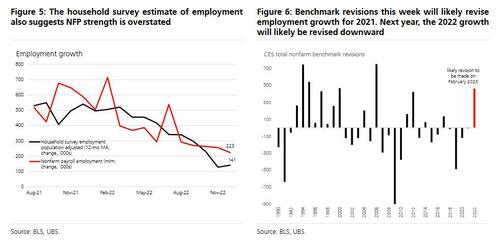
It has become impossible to be an economist or data-watcher (and thus strategist, investor, pundit or analyst) in the US: the reason is that seasonal adjustments have made virtually every data set a load of garbage, with little relevance to the real world.
Consider the latest nonfarm payroll number, where the seasonally adjusted print came at a shocking 517K, but only thanks to a near record seasonal adjustment factor which transformed a 2.5 million decline into a blowout gain which had a profound impact on market – and Fed psychology.
Or what about the latest retail sales, which also shocked to the upside, but only after generous seasonal adjustments – which are based on just some excel modeling (and a few political taps on the shoulder) converted the traditionally weak January into a blowout month.
It’s not just plain vanilla economic data: it now appears that arbitrary – and massive – seasonal adjustments are also hitting the weekly DOE oil inventory report: the past two weeks, when we saw near record inventory builds, were nothing more than the figment of some excel spreadsheet’s imagination because as the chart below shows, that’s when the DOE Crude Oil supply “adjustment” factor was one of the highest on record.
Which brings us to today’s weekly initial jobless claims report, which once again surprised to the downside, and despite wave after wave of mass layoffs (and severance), it magically dropped to four-week lows, once again underscoring just how “wonderful” Biden’s economic policies are as they translate into such a great labor market.
Which of course is horseshit only this time, it’s not zero hedge, or even UBS, but the largest US bank that is calling the bullshit on the increasingly ridiculous, politicized GIGO that comes out of the admin.
In a note from JPM’s Dan Silver, the bank’s economist points to the stubbornly, laughably low initial jobless claims, especially when considering directly tabulated reports of layoffs which in January just hit a multiyear high (according to Layoffs.fyi)…
… and politely says that “some alternative seasonal adjustments of the initial claims data show some less favorable changes in filings from recent weeks than the official figures.”
Here, JPM is merely echoing Goldman, which several weeks ago also found that initial claims are unrealistic, and that when looking at credible, state-level WARN mass layoff notices initial claims are far higher.
It’s not just JPM and Goldman, however: three weeks ago, UBS also joined the fray, and showed that yet another data series – Job Openings – is either intentionally or accidentally inflated, and that when look at third party data, the real number of job openings is about a third of what the monthly JOLTS report indicates.
What is especially funny is that banks no longer merely observe how the data no longer fits, but are making it into a type of personal crusade to expose the grotesque levels of BS emanating from the Biden admin. Case in point, another UBS economist just a few days ago published a report asking (rhetorically) if the NFP report is overestimating job gains.
But it’s not just the sellside: both the Philadelphia Fed and the BLS itself (!) recently found that the monthly NFP data is useless. Here is UBS economist Jonathan Pringle explaining why:
he Bureau of Labor Statistics reported last week that the net change in private sector jobs in 2022Q2 was -287K. In contrast, in the monthly employment report, private nonfarm payroll employment (NFP) is estimated to have risen 1.045 million! The former estimate comes from the BLS’s Business Employment Dynamics (BED) data. The latter comes from the monthly establishment survey data, NFP, the data series that usually makes the first Friday of every month an exciting one for financial markets and economists (in good ways and bad). Plus, the Federal Reserve Bank of Philadelphia staff published a paper last month estimating NFP overstated the employment gains in 2022Q2 by more than 1 million (link here). If BLS and Fed researchers say NFP was wrong, could there be some truth to that? We think so…
And here’s why:
In late September, the Bureau of Economic Analysis (BEA) revised down estimates of private wage and salaries sharply. The initial estimates are based on NFP and average hourly earnings. Those monthly estimates are replaced with a 1 to 2 quarter lag as more accurate tax records become available. The tax records are also the source data to which NFP is eventually benchmarked. The Q1 wage and salary estimates based on NFP were too strong. That large downward revision to Q1 income data was a signal that NFP might be overstating the strength of job gains. The Q2 tax records then revised down wage and salary estimates further.
How big is the data discrepancy between the real data and the published monthly NFP report? Here’s the answer to that too:
QCEW data then showed more weakness than NFP too: The Quarterly Census of Employment and Wages (QCEW) is also derived from those tax records, generally assumed to be an accurate assessment of payroll employment due to the fines employers incur for failure to properly report to the states’ unemployment insurance systems. The data covers roughly 95% of employees in the US. It is the NFP source data, in a sense. However, the data is released with a lag.
The QCEW data shows that in the 12 months ending on June 2022, job growth was 5.7 million. The current published change in NFP is 6.2 million. Plus, NFP is set to revise up by roughly 500K as of March 2022 at the annual revision to be reported next week. We expect that the upward revision reflects the strength in 2021. We expect that NFP went from understating employment strength in 2021 to overstating it in 2022.
And this is where the seasonal adjustments come in:
If the BED and QCEW point to Q2 weakness, why alter that story? Because of what we see in the BEA data and seasonal adjustment. The BEA revisions to the wage and salary data point to more overstatement in 2022Q1. In addition, the QCEW data is difficult to adequately seasonally adjust. Consider the detailed, disaggregated seasonal adjustment for the monthly employment report, and still there are periodic problems. Our guess is the estimates of 400K to 1 million jobs too many, or overstatement, in the monthly NFP data, were likely spread over 6 to 9 months. We’ll know better when we get the QCEW Q3 data in a month.
Of course, if UBS knows this, and JPM knows this, and Goldman knows this, why not just call out the BS? Simple: the Biden admin has until February 2024 to come clean, which is when the official corrections to all the data errors will be revealed, as UBS concludes:
… Unfortunately, what we, the BLS, and the Philly Fed staff see as overstatement in 2022, will not be corrected until February 2024.
In other words, there will be another 12 months of randomly fabricated data meant to serve just one narrative – a political one – instead of representing the true (sad) state of the economy. The problem is that the Fed, and the market, are both using this flawed, seasonally manipulated adjusted data to make monetary policy and capital allocation decisions; decisions which in retrospect one year from today will be proved to have been dead wrong.
By then, Powell will be long gone, Biden – having collected the big guy’s share for another 12 months – will be on his drooling way out to some tropical island paradise, but since the BLS continues to misrepresent the true state of the labor market, Fed funds may be in the double digits, leading to a historic implosion of the US economy. The only question then will be whether said gutting, like the global covid emergency and economic lockdowns, was orchestrated and by whom.
The full UBS report on payroll “ovestatement” can be found here for pro users.
Loading…



